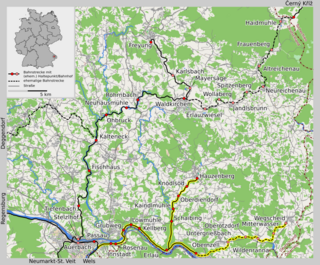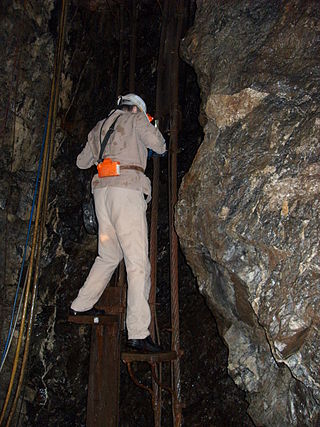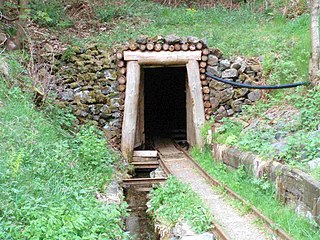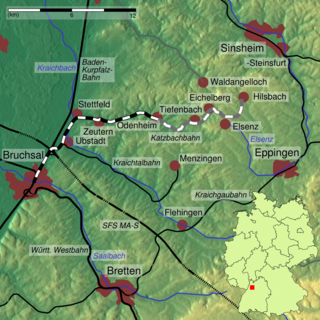
A railbus is a lightweight passenger railcar with an automotive engine. It shares many aspects of its construction with a bus, typically having a bus body and four wheels on a fixed base instead of on bogies. Originally designed and developed during the 1930s, railbuses have evolved into larger dimensions with characteristics similar in appearance to a light railcar, with the terms railcar and railbus often used interchangeably. Railbuses designed for use specifically on little-used railway lines were commonly employed in countries such as Germany, Italy, France, the United Kingdom, and Sweden.

The Stuttgart Rack Railway is an electric rack railway in Stuttgart, Germany, known affectionately as the Zacke (spike) or Zacketse by the local residents. The line opened on 23 August 1884 and links Marienplatz in the city centre to Degerloch on the Filder plateau. It is integrated with the Stadtbahn network of the Stuttgarter Straßenbahnen (SSB) and since 1978 has been line 10. At Marienplatz it connects with lines U1 and U14 and at Degerloch it connects with lines U5, U6, U8 and U12. Ordinary VVS tickets are valid.
The South Harz Railway is a railway line through the German states of Lower Saxony and Thuringia. It runs from Northeim to Nordhausen, via Herzberg am Harz, Bad Lauterberg-Barbis, Bad Sachsa, Walkenried and Ellrich. The line is 69 kilometres (43 mi) long.

The Uerdingen railbus is the common term for the multiple units which were developed by the German firm of Waggonfabrik Uerdingen for the Deutsche Bundesbahn and private railways after the Second World War. These vehicles were diesel-powered, twin-axle railbuses of light construction. The diesel motors were built into the chassis underneath the vehicle. The VT 95 and VT 98 of the former Deutsche Bundesbahn in particular, are associated with this concept. These vehicles were employed in passenger train duties on branch lines where steam or diesel train operations were less profitable. Including the units built under licence, a total of 1,492 power cars were built from 1950 to 1971; and the total number of units, including trailer and driving cars, was 3,306.

The 'Hanover version' of the Wismar railbus was developed in the early 1930s as a light railbus for economical passenger services on branch lines in Germany.

The Oder is a 56-kilometre-long (35 mi) river in Lower Saxony, Germany, and a right tributary of the Rhume. Its source is in the Harz mountains, near Sankt Andreasberg. It flows southwest through Bad Lauterberg, Pöhlde and Hattorf am Harz. The Oder flows into the Rhume in Katlenburg-Lindau.

The Brunswick State Railway Company or BLE was a railway company in the Duchy of Brunswick, a former German state centred on the city of Brunswick.

The Passau–Erlau–Hauzenberg railway is a single-tracked branch line in the Regensburg railway division with a branch to Erlau–Obernzell(–Wegscheid), which was partially operated as rack railway using the Strub rack system.

The Bomlitz–Walsrode railway is a railway line in the German state of Lower Saxony that is operated by the Osthannoversche Eisenbahnen (OHE).
The Verden–Walsrode Railway or VWE is a transport company with its headquarters in Verden on the River Aller in North Germany.

The Oder Valley Railway was a railway line that ran from Scharzfeld, through Bad Lauterberg, to St. Andreasberg-Silberhütte. It traced the upper course of the River Oder in the West Harz mountains and was commonly referred to by its namesake, the river Oder.

The Halle–Hann. Münden railway is a 218 km long main line operated by the Deutsche Bahn in Germany, which links Halle (Saale) in Saxony-Anhalt with Hann. Münden in the state of Lower Saxony. It is mainly used by regional and east-west goods trains. From 1990 to 1994 it was upgraded as part of a German Unification Transport Project.

The Samson Pit or Samson Mine is an historic silver mine in Sankt Andreasberg in the Upper Harz region of central Germany.

The Roter Bär Pit in Sankt Andreasberg in the Upper Harz is an iron ore mine that was worked from about 1800 until the 1860s. Today it is operated as a show mine under the name of Roter Bär Pit Educational Mine by the Sankt Andreasberg Society for History and Archaeology. The name Roter Bär means "Red Bear".

The Nahe Valley Railway is a two-track, partially electrified main line railway in the German states of Rhineland-Palatinate and Saarland, which runs for almost 100 kilometres along the Nahe. It was built by the Rhine-Nahe Railway Company and connects Bingen am Rhein on the Left Rhine line with Saarbrücken. It was opened between 1858 and 1860 and is one of the oldest railways in Germany. The section south of Bad Kreuznach is part of the regionally important transport corridor between the two major cities of Mainz and Saarbrücken.

The Katzbach Railway is a branch line in southwestern Germany from Bruchsal to Odenheim that opened in 1896, and was extended in 1900 to Hilsbach. In 1960 services between Tiefenbach and Hilsbach were withdrawn, in 1975 the section between Odenheim Ost and Tiefenbach followed and, in 1986, the 600-metre-long section from Odenheim station to Odenheim Ost was closed. Since 1994 the line has been operated by the Albtal-Verkehrs-Gesellschaft (AVG), who electrified it in 1998 and integrated it into the network of the Karlsruhe Stadtbahn.

Marbach (Neckar) station serves the town of Marbach in the German state of Baden-Württemberg. It is the terminus for line S 4 of the Stuttgart S-Bahn and Regionalbahn trains from Backnang. Until 1966, this was the starting point of the Bottwar Valley Railway (Bottwartalbahn), which ran all the way to Heilbronn Süd station.

Blankenburg (Harz) station is the most important station in Blankenburg in the Saxony-Anhalt district of Harz in central Germany.

The Tübingen Hbf–Sigmaringen railway is a main line railway in the German State of Baden-Württemberg. It runs from Tübingen to Sigmaringen. It is consistently single track and non-electrified, but it is equipped for the operation of tilting trains.
The Gittelde–Grund railway, also known as Kleinbahn Gittelde-Grund, was a railway line connecting the mining town of Grund at the western edge of the Harz mountains with the station of Gittelde on the Herzberg–Seesen railway. It opened in 1910 and closed in 1971.






















